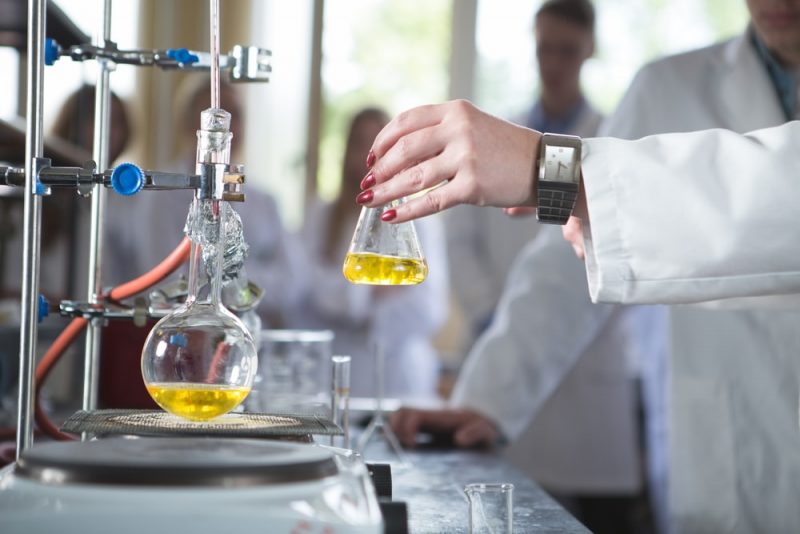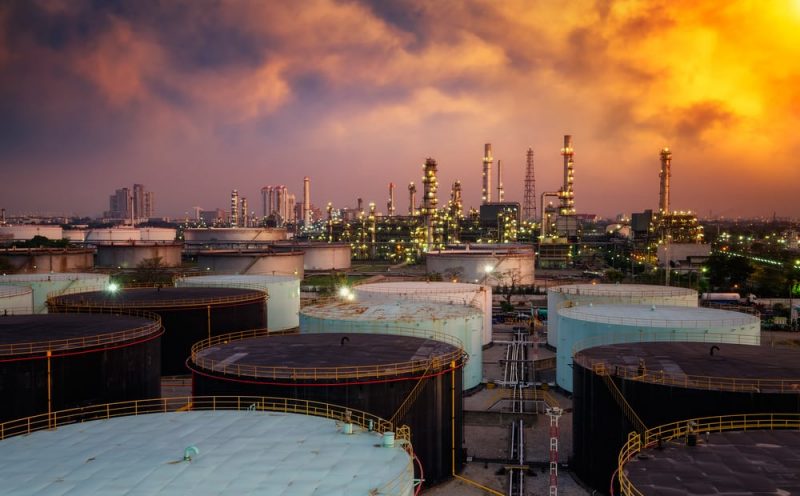The distillation It is a process of separation of substances that makes use of boiling and condensation. The method uses boiling selectively to separate the components of a generally homogeneous and liquid mixture. For example: catalytic cracking, alembic, obtaining oils.
Is homogeneous mixture It can contain liquids, a solid mixed in a liquid or liquefied gases, since the distillation is based on the differences between the boiling points of each substance that constitutes the mixture.
Is named Boiling point at the temperature at which the vapor pressure of a liquid equals the pressure surrounding the liquid. When the temperature of a liquid reaches its boiling point, it turns into gas.
In principle, for the distillation to take place, the temperature of the mixture must be increased to the boiling point of at least one of the substances that compose it, which will be conducted in a gaseous state to a container, which will then be cooled. , due to which the gas will condense and become a liquid again.
Types of distillation

There are several possible types of distillation:
- Simple distillation. It does not completely guarantee the separation of the substances. It is useful when the boiling points of the components of the mixture differ by 25 ° C or more.
- Fractional distillation. It is used when the boiling points of the substances to be separated have very close values. The liquid mixture is heated until the substance with a lower boiling point transforms into a gas. The gas then passes through a fractionation column composed of plates (structures built inside the column). On the plates the gas condenses, causing the liquid to fall onto other lower plates and then vaporize again. This cycle occurs several times to achieve a better separation of the substances in the mixture.
- Vacuum distillation. It is used when the substances to be separated have very high boiling points. The method consists of reducing the pressure of the system until a vacuum is achieved, in this way the boiling point of the components of the mixture can be reduced to achieve their separation at lower temperatures.
- Azeotropic distillation. It is used to break an azeotrope, that is, a mixture of substances that behave as one, sharing a boiling point. It often includes the presence of parting agents, which are substances that are added to the mixture to form a new azeotrope.
- Steam distillation. It is used to separate substances that decompose easily at high temperatures. Thus, instead of heating the container where the mixture is located, steam is bubbled inside so that the heating can be better controlled and thus avoid the decomposition of any component of the mixture.
- Dry distillation. It is based on heating solid materials without the help of liquid solvents, to produce gases that then condense in another container.
- Improved distillation. This is the name of alternate distillation or reactive distillation, adapted to the specific cases of mixtures of substances that are difficult to separate from their boiling points.
Examples of distillation

- Oil refining. To separate the various hydrocarbons and petroleum derivatives, a fractional distillation method is carried out that allows each of these derivative compounds to be stored in different layers or compartments, starting from the cooking of crude oil. Gases rise and dense substances such as asphalt and paraffin fall separately.
- Catalytic cracking. Vacuum distillations are often done in oil processing, from vacuum towers to separate the various gases that are given off in the oil cooking stages. In this way, the boiling of the hydrocarbons is accelerated.
- Ethanol purification. The process of separating ethanol (an alcohol) from water, the product of its production in laboratories, requires an azeotropic distillation process, in which benzene or other components are added to modify the azeotrope and allow separation.
- Coal processing. In obtaining liquid organic fuels, coal or wood are often used in a dry distillation process to condense the gases emitted during their combustion and use them in various industrial processes.
- Thermolysis of mineral salts. Another dry distillation process consisting of burning mineral salts and obtaining from them, from the emanation and condensation of gases, various mineral substances of high industrial utility.
- The alembic. This device invented in Arab antiquity to produce perfumes, medicines and alcohol from fermented fruits uses the principles of distillation by heating substances in its small boiler and cooling the gases produced in a coil cooled in a new container.
- Production of perfumes. Draft steam distillation is often used in the perfumery industry by boiling water and certain types of preserved flowers, in order to obtain an odor-filled gas that, when condensed, can be used as a base liquid in perfumes.
- Obtaining alcoholic beverages. It is possible to distill the ferment of fruits or other natural products, for example, in an alembic. The ferment is boiled at about 80 ° C (the boiling temperature of alcohol) and thus the water is separated, which remains in the container.
- Obtaining distilled water. The extreme purification of water occurs from a distillation process that extracts all the possible solutes it contains. It is often used in laboratories and industries, and the same mechanism is used to make water drinkable for human consumption.
- Obtaining oils. The recipe for obtaining many essential oils is to boil the raw material (vegetable or animal) until the oil vaporizes and then condense it in a cooled end, so that it regains its liquidity.
- Seawater desalination. In many places where there is no drinking water, sea water is used for consumption. It is distilled to remove the salt since the salt does not vaporize when the liquid is heated.
- Obtaining pyridine. Pyridine is a colorless liquid with a very repulsive odor, a compound similar to benzene, widely used in the solvent, drug, dye and pesticide industry. It is often obtained from the distillation of oil obtained, in turn, from the destructive distillation of bones.
- Obtaining sugars. From coconut and other natural substances, certain sugars can be obtained by means of a distillation that extracts the water by vaporization and allows the sugar crystals to remain unchanged.
- Obtaining glycerin. The process to obtain homemade glycerin includes the distillation of soap residues, since this substance comes from the degradation of certain lipids (as in the Krebs cycle).
- Obtaining acetic acid. This derivative of vinegar has numerous applications in the pharmaceutical, photographic and agricultural industries, and in its production processes distillation plays an important role since it is produced in conjunction with other less volatile substances such as formic acid and formaldehyde.
